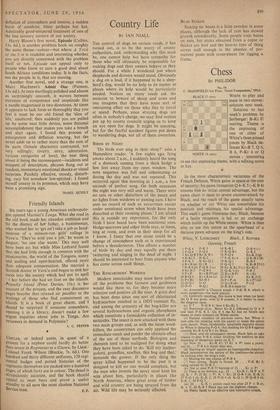Chess
BY PHILIDOR
No. 56
C. MANSFIELD (1st Prize, 'Good Companions,' 1914) BLACK (5 teen)
WHITE (6 men) WHITE to play and mate in two moves: solution next week.
In the most characteristic variations of the French Defence, White gains in space at the cost of security; his pawn formation Q 4-K 5 (-K B 4) ensures him an initial central advantage,' but the pawn chain is open to severe counter-attack by Black, and the result of the game usually turns on whether or not White can consolidate his position and maintain his spatial advantage. This week's game illustrates this; Black, because of a faulty recapture, is led to an exchange which builds up the White centre. .White is then able to use this centre as the spearhead of a decisive pawn advance on the king's side.
White, V. LJUBLINSKY Black, J. ROVNER
Opening, French
I P-K 4 P-K 3 14 R-B 2 Q-134 (/) 2 P-Q 4 ' P-Q 4 15 R-Q B I Q-R 2
3 Kt-Q B 3 Kt-K B 3 16 P-Q 4 Kt-K 2 (p) 4 B-Kt 5 B-K 2 17 P-K Kt 4 Q R-B 1 (h)
5 P-K 5 K Kt-Q 2 18 R-Q 1 R-B 5 6 BxB(a) QxB 19 Q-Q 3 K R-B 17(1)
7 P-B 4 (b) 13-Q R 3 (c) 20 Kt-K Kt 51(f) Kt-Kt 3 Kt-B 3 P-Q 114 21 Q-K 3 (k) P-R 3
9 PxP KtxBP?(d) 22Ktx13PI KxKt
10 I3-Q 3 Kt x B eh (e) 23 P-B 5 Kt-K2 (1) 11 PxKt Kt-B 3 24 P x P ch K x P? (m)
12 Q-Q 2 0-0 25 QxPchl PxQ 13 0-0 B-Q 2 26 R-B 6 mate (n)
(a) Alternative is Chatard attack 6 P-K R 4, which is more dangerous—for both players. (6) Generally speaking, this move is best when (as hero) the Q B has gone: with Q B present, it is.better to keep the diagonal open. (c) If 7 . . . P-Q 13 4; then 8 Kt-Kt 5.
(it) Positional error. Better Kt-B 3, followed by Q x P and later P-K B 3. On B 4 the Kt has no future and ceases to exert pressure on White centre.
(e) Natural corollary of previous move, but White is now able (by retaking with the pawn) to make the centre quite secure. Note, incidentally, admirable restraint shown by White in delaying P-Q 4 thus holding his Q B 4 against Possible Kt-R 4-Q 13 5 by Black. ( f) Here, and on subsequent moves, Black fails. to take chance to play P-B 4, either blocking the position or else disposing of dangerous pawn on K 5. (g) Now 16. . Kt—R. 47; 17 Kt x PI loses a pawn; but 16 .. . P-13 4 is better than text. • (6) Starting an 'attack' against an impregnable objective: Black misconceives the nature of the position—he should be looking after the king's side. (I) Missing his last chance of P-B 4.
(1 Very strong. Reply is forced, 20 . . . P-K Kt 3; being refuted by Q-R 3.
(k) Not at once P-B 5? because of 21 .. . Kt x PI (I) There is no defence, e.g., 23 . . . Kt-R 1; 24 P x P ch, K x P; 25 Kt x P1, K x Kt; 26 Q-B 3 ch, K-K 3; 27 P-Q 5 ch, K-K 2; 28 P-Q 6 ch K-Q I; 29 Q-B 8 ch, B-K 1; 30 P-Q 7, (m) 24 . . . K-K I; avoids mate but after 25 P x B eh, K x P; 26 R-B 7 Black has not the slightest chance.
(n) Pretty finish to an effective and instructive attack,


































 Previous page
Previous page